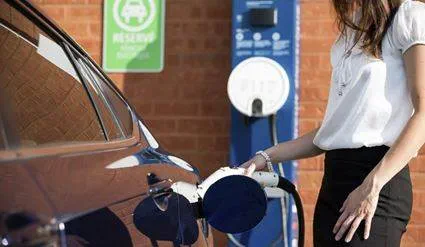
The Glue Talk Blog

Article excerpts from Adam Turner’s article originally published by DirectIndustry e-magazine.
As electric vehicles present new manufacturing and operational challenges compared to traditional combustion engines, automotive adhesive makers can’t afford to stick to their old ways.
“Electric vehicle designers often favor adhesives over mechanical fasteners in order to shed weight, as every gram impacts a vehicle’s range,” says Matt McGreevy, global marketing and product manager, Engineering Adhesives, with global adhesives manufacturer H.B. Fuller.
“With internal combustion engines, lightweighting is not driven by vehicle performance so much as government regulation to improve fuel economy and reduce CO2 emissions—for instance, the Corporate Average Fuel Economy or CAFÉ standard. In the case of electric vehicles, lightweight designs have a direct impact on the consumer experience. One of the things that’s widely understood about electric passenger vehicles is that in order for them to become truly for the mass market they need longer range. This will be the key to making them the primary household vehicle,” states McGreevy.
New Adhesives
The rise of electric vehicles is also forcing designers to pay more attention to acoustics, as they can no longer rely on the combustion engine under the hood to mask other sounds. For example, some part designers, who have traditionally relied on a tight-press fit, or friction fit, to assemble vehicle components, are now looking to add an adhesive to prevent minor rattles which were previously undetectable.
New Dual-purpose Adhesives
The need to charge and discharge batteries rapidly for improved performance also creates heat management challenges as heat can be detrimental to batteries and components and lead to safety issues. This has seen automotive designers looking to the materials used in the electronics industry when dealing with potentially volatile batteries with the need to plan for a much longer product lifespan than your typical smartphone or tablet.
This is driving the development of new robust dual-purpose adhesives which can also act as insulators or conductors. “I think you’ll see more adhesives in the electric powertrain designed to have a specific set of dielectric properties, so they don’t conduct electricity. The same goes for thermally conductive adhesives. Simply modifying an otherwise suitable adhesive to make it thermally conductive is a challenge with a reactive material. There’s always the issue of how do you change one thing without changing something else—it’s doable, but it takes know-how,” states McGreevy.
“Adhesives also have a role to play in combating the thermal runaway issues in electric vehicles which rely on lithium-ion batteries,” McGreevy says. “This issue also presents challenges for smartphone designers, as damaged batteries are prone to overheating and catching fire. There is potential for a cell failure to cascade to adjacent cells and the result is much greater in a vehicle power pack,” he explains. “Of course thermal runaway is a big safety issue that you don’t have with internal combustion engines, and it’s led to an evolution in construction materials including our patented EV Protect 4006. We heard from our customers that this was an issue and have developed an innovative encapsulation material that protects against thermal runaway, inhibiting the cascading of a cell failure and a cell fire into the adjacent cells.”
Adhesives will also play a role in helping electric car manufacturers to ramp up to large production volumes. Here different application techniques can come into play. H.B. Fuller’s McGreevy says there will always be, “a diversity of adhesive solutions,” but electric vehicle manufacturers will favor solutions that easily scale to support high-volume manufacturing.
“I think reactive adhesives which provide thermosetting performance and speed of processing are part of the future, while cure-on-demand adhesives—such as those relying on ultraviolet light—can be a process enabler. Today, we’re still seeing relatively small production volumes for electric vehicles, but over time I think the types of adhesives which will become the most frequently chosen will be the ones that lend themselves to high-volume, repetitive and automated processing characteristic of automotive manufacturing,” added McGreevy.
Learn more about H.B. Fuller's Electronic Vehicle adhesives
Blog Categories
Blog Categories
Archive
- 2024
- 2023
- 2022
-
2021
- January (3)
-
February (7)
- Celebrating Exceptional Service During COVID-19 Complications
- Cyanoacrylates: What They Are and What They Do
- Innovative two-shot bookbinding adhesive
- Make a Difference 2020
- Problem Solving: Paper Straws in Drinking Beverages
- Stronger straws sustainable future
- Substances of Interest in Disposable Absorbent Hygiene Products
- March (4)
- April (4)
- May (4)
- June (5)
- July (2)
- August (5)
- September (2)
- October (1)
- November (3)
- December (2)
-
2020
- January (4)
- February (2)
- March (3)
- April (4)
- May (3)
-
June (7)
- Community Support in the Era of Coronavirus
- HBFuller Employee Creates Face Shields with 3D Printer
- Improved Packaging Integrity and Greater Customer Satisfaction
- Liquid-Resistant Paper Straws
- What is a Sealant?
- What Is the Future of Commercial Disinfectants?
- Winning over consumers with e-commerce packaging solutions
-
July (6)
- Employees Take Action to be Part of Healing and Growth
- Gain a competitive advantage with packaging adhesive solutions
- HB Fuller Company Foundations Commitment to Communities
- Packaging Solutions for the South African Agriculture Market
- Supporting Organizations That Provide STEM Education for Youth
- Where Does Sustainability Stand Amid COVID-19
- August (3)
- September (2)
- October (4)
- November (2)
- December (4)
